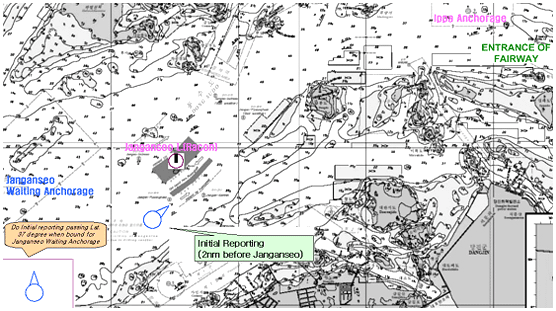VTS
VHF
Call "Pyeongtaek VTS" on VHF channel 10
Language
VTS communication would be made in Korean or English. Clear and brief communication is strongly recommended for efficient VTS communication.
VHF watch requirements
All vessels at anchor or moving within the area of the VTS coverage shall keep a VHF watch on channel 10 and 16 all the time. The VTS Center might call specific vessels to provide traffic information or to instruct them for safe traffic.
Reporting requirements for inbound vessels
Initial report- Vessels bound for Ippado waiting anchorage or Ippado pilot boarding ground shall report ship's name, call sign, ETA at Ippado waiting anchorage or Ippado pilot boarding ground and restrictions of the ship, if any, when passing 2 nautical miles SW from Janganseo Light(Racon G). It's nearly the entrance of the traffic separation scheme. If more detailed information is required, the VTS Center will ask for the information. Vessels bound for Janganseo waiting anchorage or Janganseo pilot boarding ground shall report when passing the latitude 37 degree. The VHF coverage of Pyeongtaek VTS is limited approximately up to Janganseo area. Too early calling is not recommendable for efficient communication.
- When arrived at anchorages or berths, report ship's name, call sign and arrival time(time of anchor drop or first line to shore). Usually, the harbor pilot does this reporting for the ship. When arrived at outer anchorages without a pilot, the shipmaster shall do reporting.
Shifting report
When shifting, report ship's name, call sign, shifting commencement time(time of anchor aweigh or last line to shore) destination and ETA. Completion of shifting shall be reported with the time of anchor drop or first line to shore.

Above chart extraction is quoted just only for the purpose to help understanding. For actual navigation, updated charts shall be used.


